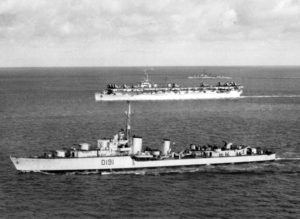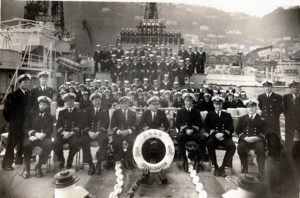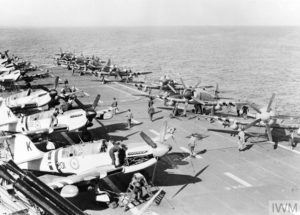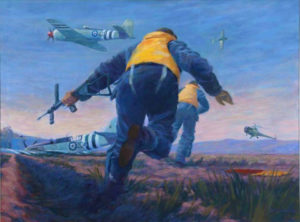On Thursday 24th June 2021 the N.A.A. (Naval Association of Australia Queensland) highlighted the service of members of the Royal Australia Navy in the Korean War.
At 4am on June 25th 1950 North Korean forces crossed the 38th parallel and invaded South Korea. Thus began the Cold War between the forces of Communism and the United Nations.
Seventy-one years ago, HMAS Shoalhaven was the first RAN ship to carry out an operation, escorting the American ammunition ship USNS Sergeant George D Keathley into Pusan harbour. Later, HMAS Bataan, fired the RAN’s first shot on 1 August 1950 when she engaged an enemy shore battery.
This conflict is often referred to as ‘the forgotten war’, despite the forces from 17 nations banding together under the UN banner to halt North Korean communist aggression.
 HMAS Bataan escorting USS Bataan off Korea
HMAS Bataan escorting USS Bataan off Korea
During the period 1950 to 1953 over 4500 sailors and Naval airmen served in the war over nine ships. Six were wounded and three Navy pilots lost their lives.
‘This war has never really ended’ said Ray Sandford, Queensland Resident of the N.A.A. ‘An armistice was agreed to by both sides, but hostilities were never declared officially over.’
The Korean War marked the beginning of the Cold War, taking the world to the brink of nuclear conflict and not finishing until Communism in Europe fell in 1991. The RAN fought alongside the United States, British, Canadian, Netherlands, New Zealand and French Navies under UN Commander, General Douglas MacArthur.
‘The conditions were terrible for the sailors’ said Ray ‘They endured constant bombardment from the shore batteries, danger from mines or running aground, yearlong deployments and freezing conditions.’ ‘ ‘At times the decks were ankle deep in snow and the aircraft engines froze up.’
Korean War Veteran Bernie Daley (88), was a fresh faced 21-year-old was sent to Korea for 12 months to serve on Shoalhaven. He was there when Shoalhaven fired its first shots in the war. Bernie served on the west coast, in submarine detection, working with the ROK (Republic of Korea) wooden minesweepers. Shoalhaven supported the coastal blockade, and had escort and bombardment duties. Despite the ship taking enemy air raids, he said that the worst part of the deployment was the weather.

‘In winter it was freezing, and the ship and our uniforms were totally unsuitable for the conditions. The condensation from the melting snow on deck dripped on to our hammocks in the mess deck and the only heater was the size of a waffle iron!’ said Bernie
‘We just wore our usual uniforms with long johns and there was one duffle coat which we shared on watch, even though it could be 11 degrees below zero.’
Most of the RAN’s deployment covered the west coast of the Peninsula, which boasted the worst possible navigational hazards. With shallow waters, extensive mud flats and islands, and large tidal movements that not only made navigation difficult, but also made it highly suitable for mine use by the North.
Nine Australian Navy ships served in the War, with 4500 sailors fighting in these conditions.
The major units involved in the war were HMAS Sydney with 805, 808 and 817 Squadrons embarked and HMA Ships Anzac, Arunta, Bataan, Tobruk, Warramunga, Condamine, Culgoa, Murchison and Shoalhaven.

Bataan and Warramunga formed part of the covering force supporting amphibious landings at Inchon, engaging enemy coastal installations and gun batteries. The Inchon landings were a success, tying down Communist forces in coastal defence rather than reinforcing the main battleline.
Warramunga’s Executive Officer, Lieutenant Commander Geoffrey Gladstone, was awarded both a bar to his Distinguished Service Cross (DSC) and the US Bronze Star for his skill and bravery in continually entering minefields in small boats to clear them.
In the Han River the frigate HMAS Murchison began eight successive days of bombardment operations in the estuary attacking enemy installations, troop concentrations, gun batteries and shore dumps. As well as dealing with a multitude of navigational hazards, Murchison came under heavy return fire during those eight days and suffered a number of hits.
In November 1951, the RAN Fleet Air Arm suffered its first combat casualty when 805 Squadron pilot Lieutenant Keith Clarkson, DFM, RAN, was shot down while diving on a road convoy in North Korea. He was the first of three naval airmen killed during the conflict.
‘There was one particularly daring rescue of downed Fleet Air Arm Aviators from behind enemy lines’ said Ray.
A Fairey Firefly fighter from 817 Squadron on HMAS Sydney was shot down by North Korean forces a hundred kilometres behind enemy lines. The crew, Sub Lieutenant Neil MacMillan and Chief Petty Officer Phillip Hancox, resisted capture with just the aid of an Owen sub-machine gun and overhead protection provided by RAN and RAAF aircraft. They were eventually rescued by Sydney’s Dragonfly helicopter piloted by Chief Petty Officer Arlene ‘Dick’ Babbit, USN, who was awarded the Commonwealth Distinguished Service Medal and the US Navy Cross.

The RAN ships were also involved in humanitarian operations delivering food and supplies to islanders on the West Coast who were struggling to survive in a war zone. After Chinese intervention Seoul was back in Communist hands, and the RAN evacuated a large number of civilian refugees.
In the Korean War Australia suffered some 1,500 casualties, including more than 350 who died and 30 who were taken prisoner. Even today, some 40 Australians are listed as missing in action.
